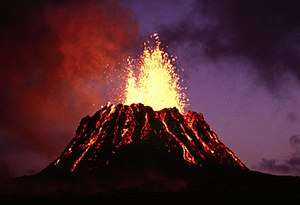Trachyte
Trachyte is an igneous volcanic rock with an aphanitic to porphyritic texture. It is the volcanic equivalent of syenite. The mineral assemblage consists of essential alkali feldspar; relatively minor plagioclase and quartz or a feldspathoid such as nepheline may also be present. (See the QAPF diagram). Biotite, clinopyroxene and olivine are common accessory minerals.
| Igneous rock | |
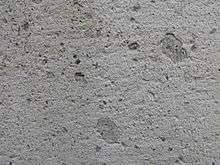 A cut sample of trachyte, with phenocrysts of sanidine, in a wall in Germany |
Chemical composition
Chemically, trachyte contains 60 to 65% silica content; less SiO2 than rhyolite and more (Na2O plus K2O) than dacite. These chemical differences are consistent with the position of trachyte in the TAS classification, and they account for the feldspar-rich mineralogy of the rock type.
Mineralogy
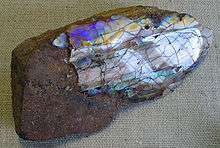
Trachytes usually consist mainly of sanidine feldspar. Very often they have minute irregular steam cavities which make the broken surfaces of specimens of these rocks rough and irregular, and from this character they have derived their name. It was first given to certain rocks of this class from Auvergne, and was long used in a much wider sense than that defined above; in fact it included quartz-trachytes (now known as liparites and rhyolites) and oligoclase-trachytes, which are now more properly assigned to andesites. The trachytes are often described as being the volcanic equivalents of the plutonic syenites. Their dominant mineral, sanidine feldspar, very commonly occurs in two generations, i.e. both as large well-shaped porphyritic crystals and in smaller imperfect rods or laths forming a finely crystalline groundmass. With this there is practically always a smaller amount of plagioclase, usually oligoclase; but the potassium feldspar (sanidine) often contains a considerable proportion of the sodium feldspar (albite), and has rather the characteristics of anorthoclase or cryptoperthite than of pure sanidine. Rhomb porphyry is an example with usually large porphyritic rhomb shaped phenocrysts embedded in a very fine-grained matrix.
Quartz is typically rare in trachyte, but tridymite (which likewise consists of silica) is by no means uncommon. It is rarely in crystals large enough to be visible without the aid of the microscope, but in thin sections it may appear as small hexagonal plates, which overlap and form dense aggregates, like a mosaic or like the tiles on a roof. They often cover the surfaces of the larger feldspars or line the steam cavities of the rock, where they may be mingled with amorphous opal or fibrous chalcedony. In the older trachytes, secondary quartz is not rare, and probably sometimes results from the recrystallization of tridymite.
Of the mafic minerals present, augite is the most common. It is usually of pale green color, and its small crystals are often very perfect in form. Brown hornblende and biotite occur also, and are usually surrounded by black corrosion borders composed of magnetite and pyroxene; sometimes the replacement is complete and no hornblende or biotite is left, though the outlines of the cluster of magnetite and augite may clearly indicate from which of these minerals it was derived. Olivine is unusual, though found in some trachytes, like those of the Arso in Ischia. Basic varieties of plagioclase, such as labradorite, are known also as phenocrysts in some Italian trachytes. Dark brown varieties of augite and rhombic pyroxene (hypersthene or bronzite) have been observed but are not common. Apatite, zircon and magnetite are practically always present as accessory minerals.
Trachytes, being very rich in potassium feldspar, necessarily contain considerable amounts of alkali; in this character they approach the phonolites. Occasionally minerals of the feldspathoid group, such as nepheline, sodalite and leucite, occur, and rocks of this kind are known as phonolitic trachytes. The sodium-bearing amphiboles and pyroxenes so characteristic of the phonolites may also be found in some trachytes; thus aegirine or aegirine augite forms outgrowths on diopside crystals, and riebeckite may be present in spongy growths among the feldspars of the groundmass (as in the trachyte of Berkum on the Rhine). Trachytic rocks are typically porphyritic, and some of the best known examples, such as the trachyte of Drachenfels on the Rhine, show this character excellently, having large sanidine crystals of tabular form an inch or two in length scattered through their fine-grained groundmass. In many trachytes, however, the phenocrysts are few and small, and the groundmass comparatively coarse. The ferromagnesian minerals rarely occur in large crystals, and are usually not conspicuous in hand specimens of these rocks. Two types of groundmass are generally recognized: the trachytic, composed mainly of long, narrow, subparallel rods of sanidine, and the orthophyric, consisting of small squarish or rectangular prisms of the same mineral. Sometimes granular augite or spongy riebeckite occurs in the groundmass, but as a rule this part of the rock is highly feldspathic. Glassy forms of trachyte (obsidian) occur, as in Iceland, and pumiceous varieties are known (in Tenerife and elsewhere), but these rocks as contrasted with the rhyolites have a remarkably strong tendency to crystallize, and are rarely to any considerable extent vitreous.
Geographic distribution
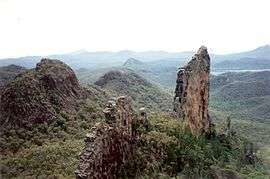
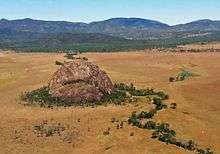
Trachytes are well represented among the Cenozoic volcanic rocks of Europe. In Britain they occur in Skye as lava flows and as dikes or intrusions, but they are much more common on the continent of Europe, as in the Rhine district and the Eifel, also in Auvergne, Bohemia and the Euganean Hills. In the neighborhood of Rome, Naples and the island of Ischia trachytic lavas and tuffs are of common occurrence. Trachytes are also found on the island of Pantelleria. In the United States, trachytes crop out extensively in the Davis Mountains, Chisos Mountains, and Big Bend Ranch State Park in the Big Bend (Texas) region, as well as southern Nevada and South Dakota (Black Hills). There is one known voluminous flow from Pu'u Wa'awa'a on the north flank of Hualalai in Hawaii. In Iceland, the Azores, Tenerife and Ascension there are recent trachytic lavas, and rocks of this kind occur also in New South Wales (Cambewarra Range), Queensland (Main Range),[1] East Africa, Madagascar, Yemen and in many other districts.
Among the older volcanic rocks trachytes also are not scarce, though they have often been described under the names orthophyre and orthoclase-porphyry, while trachyte was reserved for Tertiary and recent rocks of similar composition. In England there are Permian trachytes in the Exeter district, and Carboniferous trachytes are found in many parts of the central valley of Scotland. The latter differ in no essential respect from their modern representatives in Italy and the Rhine valley, but their augite and biotite are often replaced by chlorite and other secondary products. Permian trachytes occur also in Thuringia and the Saar district in Germany.
Closely allied to trachyte is the rock type called keratophyre, which is the sodium-rich-plagioclase equivalent of trachyte.[2]
See also
Notes
- Stevens, Neville (September 1996). The Main Range (PDF). Brisbane, Queensland: Geological Society of Australia. Archived from the original (PDF) on 2008-07-19.
- Schermerhorn, L. J. G. (January 1973). "What is keratophyre?". Lithos. 6 (1): 1–11. Bibcode:1973Litho...6....1S. doi:10.1016/0024-4937(73)90076-5.
References

External links
| Wikimedia Commons has media related to Trachyte. |
